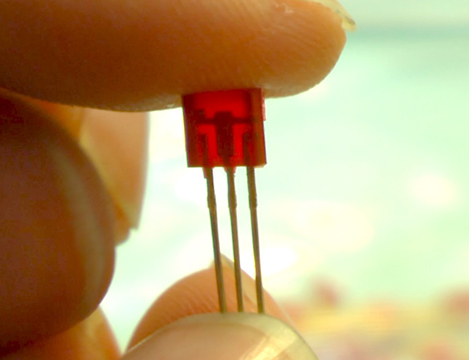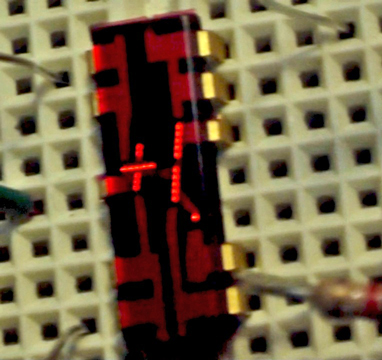"Humorous
Birthday Card" In-A-Box Hack
(January 2014)

I have been very fond of
the really funny audio greeting cards made by 'that greeting card company'
featuring 'those cute funny characters' for some time. A humorous
card is nice, but a humorous birthday card hacked in-a-box is a real gift
that keeps on giving! So I set out to make just that - for my Dad's
70th.
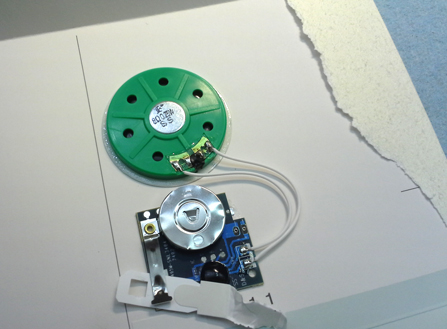
First, I bought one of those
adorable funny audio cards from that greeting card company's store.
Then I tore it open and pulled the electronics out that were glued to the
back of the card on the inside of a fold.

Next, I prepared a heavy
plastic food container that was of the right size to contain a AAA battery
holder, a pushbutton switch, the speaker, and the audio PCB. I drilled
holes in the lid for the speaker and the pushbutton. This was going
to be sooooo easy.

Next I had to remove the
battery cover and switch that were on the PCB and take out the CR2032 3V
lithium battery that the greeting card ran on so that I could hook up a
more robust set of replacable AAA batteries.
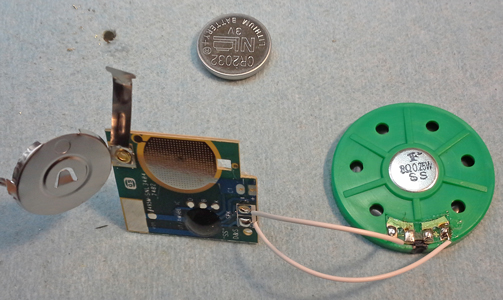
And here is where it got
interesting - because any attempts to power the little potted chip with
any kind of higher current 3VDC source would fail to operate the chip.
Using 2 AAA lithium batteries at 3.5VDC just caused the speaker to chirp.
A little over-voltage, I thought. Hooking it up to my variable bench
supply I found that as I slowly reduced the supply voltage from around
4VDC on down that the audio output became longer and longer, and it played
more and more of the recording as the voltage dropped. At around
2VDC It played the entire message. It seems as though some kind of
sensing circuit on the input varies the total playback time of the chip
relative to the current supplied under load. The RC clock seemed
to remain at relatively the same speed between 3VDC and 2VDC, based on
the playback, but the time it would run changed greatly. I
found that any change in impedance in the power supply, like dirty clip
leads to a battery or long leads, would effect whether it played or not,
how much of the message it played, and for how long. (It may also
be sensitive to the specific capacitance of the CR2032 cell, hard to tell)
I speculated that this could have been engineered in as a clever way to
keep people from taking the board out of the card and doing anything inappropriate
with it, like hooking it up to a larger capacity battery so that you could
play it forever. Like what I did. I found that a new
single lithium AAA battery had just about the right supply voltage of around
1.8VDC to run the humorous recording at a higher current capacity than
the 3V lithium watch battery it came with.
[Whenever I placed the CR2032
cell back in the round holder and pushed down on it to contact the PCB
it played normally. There are no traces on the bottom side of the
PCB, and I could find no resistance in the battery holder or other obvious
things that could be involved. I tried this same experiment
with three identical PCBs with the same results. Go figure.]
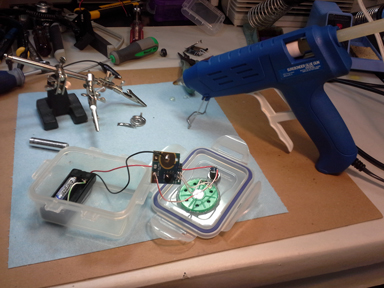
Then I used my glue gun
to secure the battery holder and speaker in the food container, and I had
to bypass the second slot in the battery holder to use just the single
AAA for this. I wired the positive supply through the pushbutton
and to the PCB and it was done. Piece of cake! Birthday cake,
that is....

All done! Enjoy!








